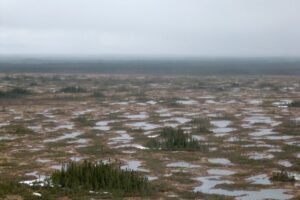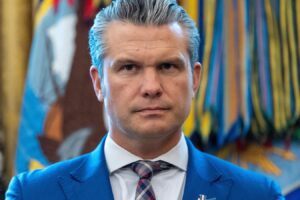
If you’ve been watching the Toronto Blue Jays on this historic World Series run, you’ve probably seen the Government of Ontario’s advertisements about mining in the Ring of Fire.
As I tuned in from the bandwagon the other night, blue jerseys gave way to coveralls, headlamps shining through tunnels and a Canadian flag waving in front of a forest and lake with a highway hugging its shore; all as a narrator laid out the economic potential of minerals underground far, far from these places.
Taken at face value, the ads might have you thinking roads in the Ring of Fire are paved (because that’s what you see), mine shafts are dug (because that’s what you see) and mills are processing ore (because that’s what you see).
One small problem: that’s not really the case. I don’t know much about baseball, but I do know that actual mining in the Ring of Fire is much further away — and much more complicated — than those ads portray.
So why are the commercials about mining in the highly coveted and highly undeveloped region on Treaty 9 territory, some 500 kilometres northeast of Thunder Bay, Ont., framed as a project that’s already underway?
It’s a clever marketing play.
Millions of World Series viewers seeing the landscape, supposedly already altered by roads and mines, may make a more comfortable leap to accepting more roads, mines and more development in general.
If the ads on the Blue Jays broadcast showed the sprawling peatlands, scattered with trees, lakes and rivers that actually make up the Ring of Fire, it might feel a bit harder to sever: the first cut is the deepest.
Ontario Premier Doug Ford has been pushing for a mining boom, especially in the far-north Ring of Fire region, shown here. Advertisements paid for by the province have aired during World Series broadcasts, showing workers in tunnels and developed mines and roads, but it’s not the Ring of Fire they’re showing. Photo: Casa Di Media
The Ring of Fire, as it’s come to be known, is said to hold massive amounts of the minerals needed for things like electric vehicle batteries. Just how much has been debated, with many critics suggesting the province’s estimate of $90-billion worth is overstated. The province has also said mining in the region will add $22 billion to Ontario’s economy over three decades. (Since taxpayers shelled out for them: the Globe and Mail found Ring of Fire ads took up more time than any other spots, aside from Rogers itself, and could have cost up to $150,000 per spot — more if we go to game 7.)
Despite a slew of mining claims and exploration work as companies have taken interest in the region over the past couple decades, there is no mine actually in operation there yet. The most advanced proposal is Wyloo Metals’ Eagle’s Nest nickel, platinum and copper project. At a press conference on Oct. 29, announcing a community partnership agreement with Webequie First Nation, Greg Rickford, the provincial minister charged with Indigenous affairs and economic development and partnerships in the Ring of Fire, hinted at just how far along mining development is: “Later today, I’m meeting with Wyloo, and the question to them is going to be, how ready are you now to proceed with at least the preliminary activities associated with mine construction.” That doesn’t exactly sound like the ting of shovels hitting the ground.
The day before the press conference, Neskantaga First Nation, a nearby community of roughly 400 people, requested the federal government undertake an impact assessment of the Eagle’s Nest project. In an Oct. 28 letter to federal Environment Minister Julie Dabrusin, Neskantaga Chief Gary Quisess said the mine “is likely to cause severe adverse effects in areas of federal jurisdiction, particularly on Indigenous peoples including our First Nation, fish and fish habitat, as well as migratory birds.”
The Ontario government’s ads mention Indigenous economic prosperity, but not First Nations’ constitutional rights — which is no small issue, and already a flashpoint.
This summer, people from both Neskantaga and Attawapiskat First Nation gathered along the Attawapiskat River at one of the points that would be crossed by a road to the Ring of Fire. They reached the area by boat, setting up a camp to protest the region’s development without proper First Nations consultation.
The province has various agreements signed with some First Nations and faces massive opposition from others. Those agreements concern roads going to the region, which Webequie and Marten Falls First Nations support, not necessarily because of access to the mining district, but because of the way road access could improve quality of life for their communities.
In September, the province also made splashy announcements about a $62-million investment to ready the “gateway to the Ring of Fire,” in Geraldton, Ont. The money was for upgrading existing roads, but Rickford noted in a press release, “This is more than a roadworks project — it’s a signal that Geraldton is a gateway to one of Ontario’s greatest assets in the face of economic threats from the United States, and that our government is serious about supporting the communities that anchor the North.”
These exaggerations play into the public’s perception of these massive projects with massive impacts that are not yet realized.
But being hyperbolic about progress on its pet projects is a Ford government hallmark. It has also been criticized for talking up the construction starts on Highway 413 — the proposed 60-kilometre highway running through the Greenbelt, north and west of Toronto. Those starts include an embankment for a future highway connection to the 401 and resurfacing existing roads near the proposed route, but that’s not exactly building a highway — and it hasn’t happened without criticism.
Like the Ring of Fire ads, it wields the influence of the sunk cost fallacy. The further we get into building costly roads and mines into the remote region, the harder it is to step away and take that loss. But the promotions obscure the fact that we haven’t gotten that far, and Ontario’s pitch for economic prosperity is still well out of the strike zone.





